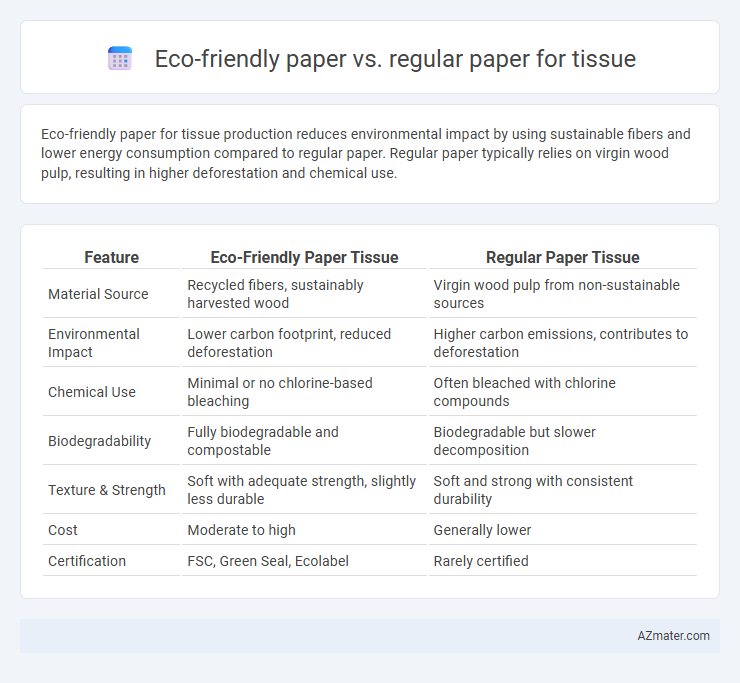Eco-friendly paper for tissue production reduces environmental impact by using sustainable fibers and lower energy consumption compared to regular paper. Regular paper typically relies on virgin wood pulp, resulting in higher deforestation and chemical use.
Table of Comparison
| Feature | Eco-Friendly Paper Tissue | Regular Paper Tissue |
|---|---|---|
| Material Source | Recycled fibers, sustainably harvested wood | Virgin wood pulp from non-sustainable sources |
| Environmental Impact | Lower carbon footprint, reduced deforestation | Higher carbon emissions, contributes to deforestation |
| Chemical Use | Minimal or no chlorine-based bleaching | Often bleached with chlorine compounds |
| Biodegradability | Fully biodegradable and compostable | Biodegradable but slower decomposition |
| Texture & Strength | Soft with adequate strength, slightly less durable | Soft and strong with consistent durability |
| Cost | Moderate to high | Generally lower |
| Certification | FSC, Green Seal, Ecolabel | Rarely certified |
Introduction to Tissue Paper Types
Eco-friendly tissue paper is crafted from sustainable sources such as recycled fibers or bamboo, reducing environmental impact through lower deforestation and water usage compared to regular tissue paper made from virgin wood pulp. These sustainable alternatives often feature biodegradable and chemical-free properties, promoting healthier ecosystems. Regular tissue paper, usually bleached and processed with chemicals, provides softness and strength but contributes to higher carbon footprints and resource depletion.
What is Eco-Friendly Tissue Paper?
Eco-friendly tissue paper is made from sustainable materials such as recycled fibers, bamboo, or organic cotton, reducing environmental impact compared to regular paper derived primarily from virgin wood pulp. It utilizes eco-conscious production methods minimizing water and energy consumption while avoiding harmful chemicals and bleach. This sustainable approach enhances biodegradability and reduces carbon footprint, supporting conservation efforts and responsible forestry practices.
The Manufacturing Process: Eco-Friendly vs Regular Tissue
Eco-friendly tissue manufacturing utilizes sustainable raw materials like bamboo or recycled fibers, significantly reducing deforestation and environmental impact compared to regular tissue made from virgin wood pulp. The production process often incorporates chlorine-free bleaching and less water consumption, resulting in lower carbon emissions and toxic byproducts. In contrast, regular tissue manufacturing relies heavily on chemical-intensive treatments and high energy usage, contributing to pollution and habitat degradation.
Raw Materials Used in Tissue Production
Eco-friendly tissue paper is primarily made from sustainable raw materials such as recycled fibers, bamboo, or agricultural residues, reducing reliance on virgin wood pulp and minimizing deforestation. Regular tissue paper commonly uses virgin wood pulp sourced from trees, which involves higher energy consumption and greater environmental impact during harvesting and processing. The choice of raw materials directly influences the ecological footprint of tissue products, with eco-friendly options promoting resource conservation and lowering carbon emissions.
Environmental Impact: Deforestation and Carbon Footprint
Eco-friendly tissue paper significantly reduces deforestation by utilizing recycled fibers and sustainable forestry practices, minimizing the need to harvest virgin trees. This approach lowers the carbon footprint through decreased energy consumption and reduced greenhouse gas emissions during production. In contrast, regular tissue paper often relies on virgin pulp, contributing to habitat loss, increased carbon emissions, and greater environmental degradation.
Biodegradability and Waste Management
Eco-friendly tissue paper exhibits superior biodegradability compared to regular paper, typically decomposing within weeks due to its natural fibers and absence of synthetic additives. This rapid breakdown significantly reduces landfill accumulation and facilitates efficient organic waste management. In contrast, regular tissue paper often contains chemical treatments and bleaches that slow decomposition, complicating waste processing and increasing environmental impact.
Health Considerations: Chemical Additives and Allergens
Eco-friendly tissue paper typically contains fewer chemical additives and dyes than regular paper, reducing the risk of skin irritation and allergic reactions. Regular tissue often includes bleaching agents and fragrances that can trigger sensitivities, especially for individuals with eczema or respiratory conditions. Choosing eco-friendly options supports healthier skin and respiratory systems by minimizing exposure to harmful allergens and toxins.
Cost Comparison: Eco-Friendly vs Regular Tissue
Eco-friendly tissue paper typically incurs higher production costs due to sustainable sourcing, organic fibers, and eco-conscious manufacturing processes, resulting in a price premium compared to regular tissue paper. Regular tissue paper benefits from cheaper raw materials like virgin wood pulp and conventional bleaching methods, making it more cost-effective for mass production and widespread use. However, rising environmental regulations and consumer demand for sustainable products are gradually narrowing the cost gap between eco-friendly and regular tissue papers.
Consumer Awareness and Market Trends
Eco-friendly paper tissues, made from recycled fibers and sustainable sources, are gaining traction as consumer awareness of environmental impact grows, driving demand in the tissue market. Market trends indicate a significant shift towards biodegradable and chemical-free options, with consumers prioritizing products that reduce deforestation and pollution. Competitive brands are increasingly incorporating certifications like FSC and Ecolabel to appeal to eco-conscious buyers, reflecting a major trend in sustainable consumer goods.
Choosing Sustainable Tissue: Tips for Consumers
Selecting eco-friendly tissue paper drastically reduces environmental impact by utilizing recycled fibers and sustainable forestry practices, unlike regular paper which often relies on virgin pulp contributing to deforestation. Consumers should look for certifications such as FSC (Forest Stewardship Council) and Ecolabel to ensure responsible sourcing and biodegradability. Prioritizing bamboo and recycled content tissues supports sustainable consumption and minimizes landfill waste.

Infographic: Eco-friendly paper vs Regular paper for Tissue
 azmater.com
azmater.com